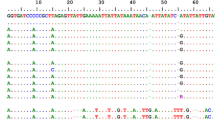Abstract
A 6-year-old Labrador with history of hyperpnea, respiratory distress, ascites and paraparesis, presented Dirofilaria immitis microfilariae in the blood smear, cytology of the abdominal fluid and urine. The positive samples were confirmed by multiplex-PCR (COI gene) and sequencing, and presented 98% homology to D. immitis (GenBank accession nos. KC107805.1, EU159111.1, EU163945.1, DQ358815.1, and AJ537512-1). Based on the presented results and the physiopathology of the heartworm disease, molecular techniques may be helpful and accurate in the diagnosis of the disease in vertebrates, and microfilaruria, even uncommon, should be considered on a renal failure evaluation.



Similar content being viewed by others
References
Acha P, Szyfres B (2003) Zoonosis y enfermedades transmisibles communes al hombre y a los animals, 3rd edn. Organización Panamericana de la Salud, Geneva
Ambily VR, Usha NP (2012) Microfilariosis in dogs—an emerging cause for renal failure. Int J Sci Res 3:1554–1556
Da Silva RC, Langoni H (2009) Dirofilariasis. Neglected emerging zoonosis. Ciênc Rural 39:1614–1623
Dantas-Torres F (2008) Canine vector-borne diseases in Brazil. Parasite Vectors 1:25
Fernandes CGN, Rodrigues-Silva R, Moura ST, Oliveira RMF (2000) Epidemiological aspects of canine dirofilariasis in the metropolitan area of Cuiabá, Mato Grosso: the use of “Immunoblot” and of modified Knott test. Braz J Vet Res Anim Sci 37(6). doi:10.1590/S1413-95962000000600009
Kaewthamasorn M, Assarasakorn S, Niwetpathomwat A (2008) Microfilaruria caused by canine dirofilariasis (Dirofilaria immitis): an unusual clinical presence. Comp Clin Pathol 17:61–65
Labarthe N, Guerrero J (2005) Epidemiology of heartworm: what is happening in South America and Mexico? Vet Parasitol 133:149–156
Latrofa MS, Weigl S, Dantas-Torres F, Annoscia G, Traversa D, Brianti E, Otranto D (2012) A multiplex PCR for the simultaneous detection of species of filarioids infesting dogs. Acta Trop 122:150–154
Pereira LL, Coletta RD, Monteiro LC, Ferreira VYN, Leon JE, Bonan PRF (2015) Dirofilariasis involving the oral cavity: report of the first case from South America. Rev Soc Bras Med Trop 48:361–363
Polizopoulou ZS, Koutinas AF, Saridomichelakis MN, Patsikas MN, Leontidis LS, Roubies NA, Desiris AK (2000) Clinical and laboratory observations in 91 dogs infected with Dirofilaria immitis in northern Greece. Vet Rec 146:466–469
Souza NF, Larsson MHMA (2001) Frequency of canine heartworm disease (D. immitis) in some regions of São Paulo State using a circulating antigen indicator test. Arq Bras Med Vet Zootec 53:321–325
Venco L, Kramer L, Genchi C (2005) Heartworm disease in dogs: unusual clinical cases. Vet Parasitol 133:207–218
Acknowledgements
The authors thank Sao Paulo State University for the logistical support, and report no conflict of interest for this study.
Author information
Authors and Affiliations
Corresponding author
Rights and permissions
About this article
Cite this article
Monobe, M.M., da Silva, R.C., Araujo Junior, J.P. et al. Microfilaruria by Dirofilaria immitis in a dog: a rare clinical pathological finding. J Parasit Dis 41, 805–808 (2017). https://doi.org/10.1007/s12639-017-0892-8
Received:
Accepted:
Published:
Issue Date:
DOI: https://doi.org/10.1007/s12639-017-0892-8




